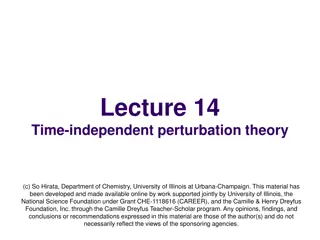Introduction to Lagrangian and Hamiltonian Mechanics: A Comprehensive Overview
This course provides a detailed introduction to Lagrangian and Hamiltonian Mechanics, covering topics such as the nature of physics, differentiation, calculus of variation, coordinate systems, and getting ready for Lagrangian Mechanics. It explores the relationship between math and physics, utilizing tools like Mathematica for numerical solutions in physics problems. The content also delves into vector definitions, kinetic energy in different coordinate systems, and solving differential equations in mechanics scenarios. Prepare to dive deep into theoretical and practical aspects of classical mechanics.
Download Presentation

Please find below an Image/Link to download the presentation.
The content on the website is provided AS IS for your information and personal use only. It may not be sold, licensed, or shared on other websites without obtaining consent from the author.If you encounter any issues during the download, it is possible that the publisher has removed the file from their server.
You are allowed to download the files provided on this website for personal or commercial use, subject to the condition that they are used lawfully. All files are the property of their respective owners.
The content on the website is provided AS IS for your information and personal use only. It may not be sold, licensed, or shared on other websites without obtaining consent from the author.
E N D
Presentation Transcript
Introduction to Lagrangian and Hamiltonian Mechanics Day-1: Introduction Zain Yamani CENT Director @ KFUPM SPS Vice President
Introduction The nature of physics.. What do we study.. What we do not?? How we express ourselves. The fields of physics.. Physics in nature and technology The methods of physics Dealing with number/ math in physics What is the relation between math and physics (Data: Tables.. Figures.. Equations) Using our imagination when we draw graphs (evolution of location (x,y,z) in time, for example).. or v(t) or U(x) or ?
Introduction Differentiation Partial differentiation Find a minimum of a function.. through differentiation. Using Mathematica.. Symbolically, Numerically.. A bit about Mathematica Expound on numerical solutions in physics problems
Introduction to Lagrangian and Hamiltonian Mechanics Day-2: Calculus of Variation Outline: 1. Review 2. Coordinate systems 3. A step back to Newtonian Mechanics 4. Calculus of Variations
Coordinate systems Euclidean Orthogonal Rotation Definition of a (2-D) vector Definition of a (3-D) vector [What about 4-D vector?]
Coordinate systems Cartesian coordinates (position, velocity, acceleration etc.) Spherical coordinates (same thing ) Cylindrical coordinates (here too) Defining operators: gradient, divergence, curl, Laplacian Kinetic energy in Cartesian and non-Cartesian systems Generalized Coordinates; degrees of freedom, constraints
Introduction to Lagrangian and Hamiltonian Mechanics Day-3: Get Ready for Lagrangian Mechanics Outline: 1. Review 2. A step back to Newtonian Mechanics 3. Variational Calculus 4. Lagrangian Mechanics
A step back with mechanics.. Newton s Law Free fall, down the frictionless incline, mass-spring system, pendulum Points of equilibria Solving differential equation: Ordinary DE.. 1st order, 2nd order.. constant coefficients.. non constant coefficients (Legendre.. Hermite ) Partial DE
Calculus of Variations Functional; independent; dependent (one more more) Action The handout for Euler Equation (ref. Fox).. From my website With/without constraints Prove that the short distance between two point in Euclidean space is a straight line (in a plane, in 3-D).
Introduction to Lagrangian and Hamiltonian Mechanics Day-4: Lagrangian Mechanics Outline: 1. Review 2. Lagrangian Mechanics
Lagrangian Mechanics Hamilton s principle.. Minimize the action with the Lagrangian [L = T-V] as functional Euler Lagrange Equations (ELE) Example-1: Freely falling object Example-2: Projectile motion (neglecting air resistance) Example-3: slide down an incline (1-D) Example-4: mass spring system Example-5: the simple pendulum Example-6: solving the impossible Example-7: slide down an incline revisited (2-D + constraint) Example-8: the sliding bead on the rotating circular rim
Introduction to Lagrangian and Hamiltonian Mechanics Day-5: Hamiltonian Mechanics Outline: 1. Review 2. Lagrangian Mechanics with constraints 3. Hamiltonian Mechanics
Lagrangian Mechanics Conjugate momentum Cyclic coordinates What about: - Constraints: the Euler-Lagrange equation is stated slightly differently - Velocity dependent potential [L is defined differently]
Hamiltonian Mechanics Legendre transformations: L H Ignorable coordinates Doing mechanics using the Hamiltonian (the canonical equations) Example-1: Freely falling object Example-2: Projectile motion (neglecting air resistance) Example-3: mass spring system Example-4: the simple pendulum Example-5: The central force problem (mostly Lagrangian Mechanics)
Hamiltonian Mechanics A step into quantum mechanics Hamiltonians























